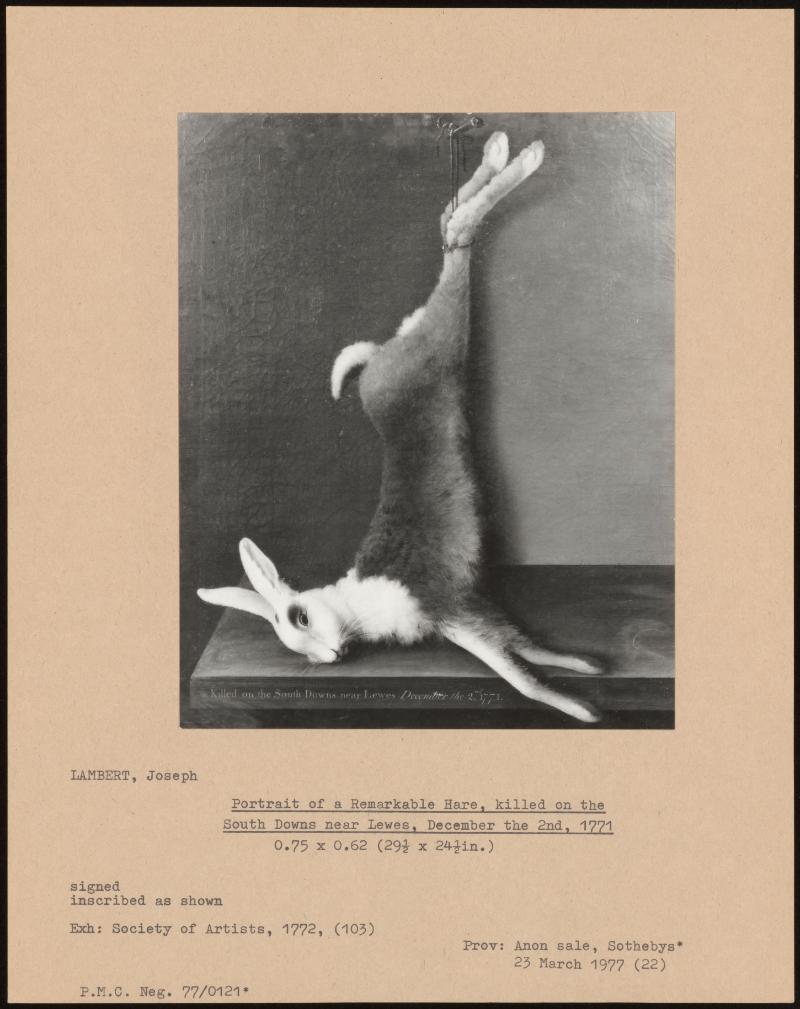Case Study 1: James Lambert, “A Remarkable Hare”
While casually browsing through the digital photo archive in the course of preparing this article, I came across an intriguing image which I had never seen before, and which appeared to epitomise the spirit of the Centre’s early photo archive activities (Fig. 1). The work in question, as the photographic mount revealed, had been sold at Sotheby’s on 23 March 1977, lot 22. A quick check of the relevant Sotheby’s catalogue, also in the collection of the Paul Mellon Centre, confirmed that it did not feature an image of the work in question, although it did contain an annotation by a member of the PMC’s staff indicating that it had been singled out for photography. In Sotheby’s catalogue entry, aside from the title, an artist’s name, “Joseph Lambert”, and the work’s dimensions, there was no record of the picture’s identity. The PMC mount, however, revealed that the painting had been exhibited originally at the Society of Artists, London, in 1772, number 103. This valuable information was, without doubt, provided by one of the Centre’s own staff (probably Brian Allen), who had conducted some background research. Taking up this lead, I examined the original manuscript of the 1772 exhibition catalogue, which is now held in the archive of Princeton University.1 There, the picture was entitled “The portrait of a remarkable hare, killed on the South Downs, near Lewes, Dec. 2, 1771”.

Fig. 1
James Lambert Senior, Portrait Of A Remarkable Hare, Killed On The South Downs Near Lewes, December The 2nd, 1771. Paul Mellon Centre Photographic Archive (PA-F05426-0003)
The artist responsible for the painting, as the Society of Artists catalogue revealed, was “Mr Lambert, of Lewes, Sussex, at Mr Utonson’s, No 48 Bell Yard – Temple Bar”. The artist’s name given on the PMC mount, following the name supplied by Sotheby’s, was “Joseph Lambert”. However, as I subsequently learned, he was in fact James Lambert Senior (1725–1788) of Lewes, Sussex, who worked not only as a painter but also as a bookseller, stationer, and musician.2 Along with the “remarkable hare” he exhibited four other works, including a large landscape featuring a south-east view of “Hurstmonceaux Castle, Sussex, a print of which is in the collection of the Yale Center for British Art (Fig. 2: B1977.14.1095). Again, the exhibition of the original painting in 1772 assists in dating the print, which was hitherto undetermined. As for “Mr Utonson of Bell Yard”, evidently Lambert’s London landlord, I discovered that he was the wonderfully named Onesimus Utonson, who operated a fishing tackle export business at the Fish and Crown in Bell Yard, on the corner of Fleet Street. Among Utonson’s customers was the botanist Sir Joseph Banks who, in June 1772, at the very time Lambert’s picture was being exhibited, purchased tackle for the second Antarctic voyage of Captain Cook on board the Resolution.3 In the event, Banks did not sail. Of course, this aside is admittedly quite tangential to Lambert’s painting. However, it does underline how an image of one seemingly minor work of art contained in the PMC archive can so readily reveal elements of a hitherto untold story concerning an artist’s life and times.

Fig. 2
James Lambert of Lewes, Herstmonceux Castle, East Sussex: South East View. Yale Center for British Art, Paul Mellon Collection (B1977.14.1095)
Footnotes
- Princeton ref: https://babel.hathitrust.org/cgi/pt?id=njp.32101076187192&view=image&seq=298.↩︎
- See “Family Lambert. The two James Lamberts 1725–1788 and 1741–1799, https://www.familylambert.net/james-lambert.html.↩︎
- Graham Turner, “The Utonson Dynasty 1760s–1885”, chapter 3, in Fishing Tackle. The Ultimate Collector’s Guide, https://docplayer.net/51117072-The-ustonson-dynasty-1760s-1855.html.↩︎